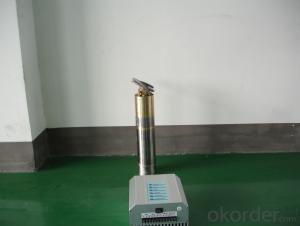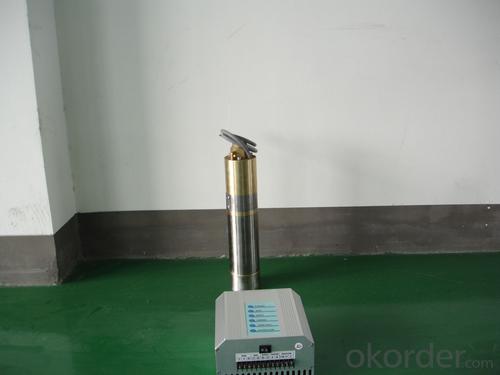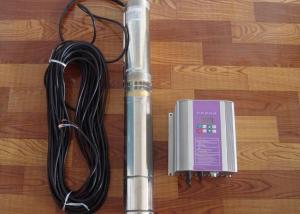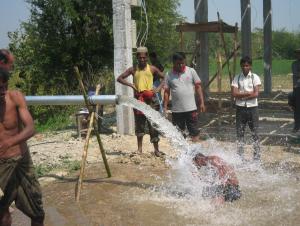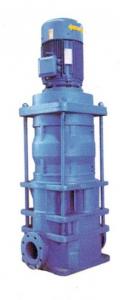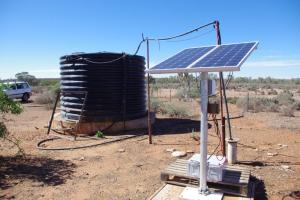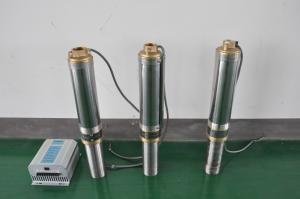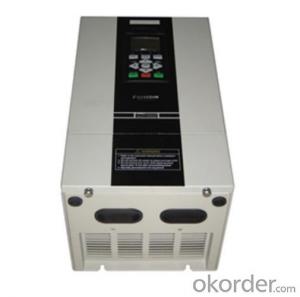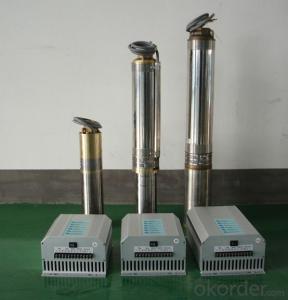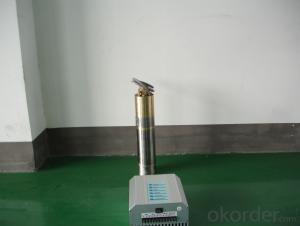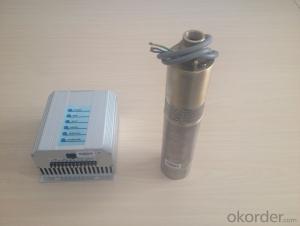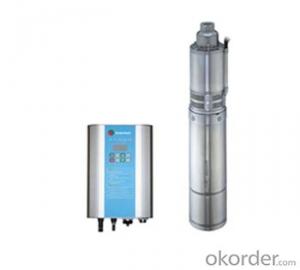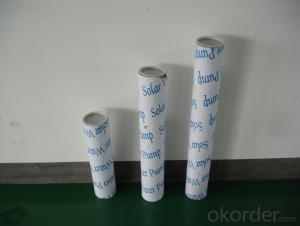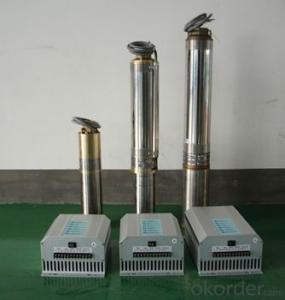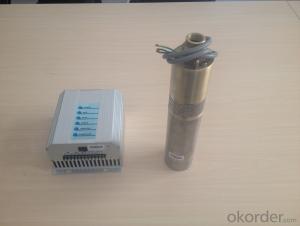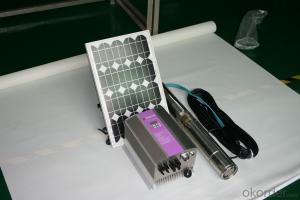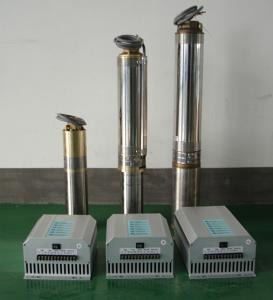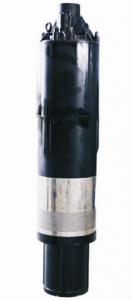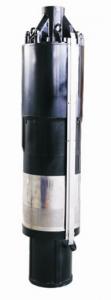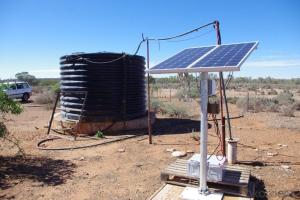Aquaponics Solar DC Solar Submersible Pumps
- Loading Port:
- China Main Port
- Payment Terms:
- TT OR LC
- Min Order Qty:
- -
- Supply Capability:
- -
OKorder Service Pledge
OKorder Financial Service
You Might Also Like
Item Description :
This superb new addition to our solar fountain range comes with a 10w solar panel,and a powerful fountain pump that is capable of producing fountains of up to 2m in height. As well as being easy to set up and use.Instruction manual is supplied for assembly and maintenance.
Solar Fountain Key Features :
Powered by direct sunlight
No high voltage electric mains required
Safe for children
Max. height of fountain: 2M
Max. flow capacity: 800 L/H(176 GAL)
10W Polycrystalline solar panel included
18V DC brushless pump
Solar Pump Features :
Can produce fountains up to : 2M (tube height) 1.4M (fountain height)
Comes with multiple nozzle accessories
Cable Length : 5M
Solar Panel Features :
10W peak power.
Polycrystalline highly efficient solar panel
Comes mounted in aluminium frame
Comes with ground stake and rotating knob so you can angle your panel toward the sun
What You Will Get :
10W solar panel
Solar pump
Ground Sake
Nozzle accessories
Precautions :
DO NOT alter or change the product itself or its components
Operate pump in freshwater only, never above 50 degrees celsius
Keep away from flammable liquids
Do not connect to any other power supply other than the included
- Q: Can a solar pump be used for water supply in mining operations?
- Yes, a solar pump can be used for water supply in mining operations. Solar pumps are an efficient and cost-effective solution for remote locations where access to electricity may be limited. They can provide a reliable and sustainable water supply, helping to meet the water demands of mining operations while reducing reliance on traditional power sources.
- Q: Can a solar pump be used for water supply in schools or community centers?
- Certainly, a solar pump can be utilized for water supply in schools or community centers. Solar pumps offer a dependable and sustainable solution for water supply by utilizing solar energy to extract water from wells, rivers, or other sources. They prove particularly suitable for areas with limited electricity access or an unreliable power grid. Installation, operation, and maintenance of solar pumps are effortless. They function without the need for fuel or electricity, which makes them both cost-effective and environmentally friendly. This quality also enables their usage in remote areas without access to grid electricity. Within schools or community centers, solar pumps can be employed to ensure a consistent water supply for various purposes, including drinking, sanitation, and irrigation. By pumping water into storage tanks, they guarantee a continuous and hygienic water supply for the community. Moreover, solar pumps can be integrated with other water treatment systems, for instance, filtration or purification units, to guarantee the safety of the supplied water for consumption. This renders them an ideal solution for addressing water scarcity and enhancing access to clean water in schools and community centers.
- Q: How does the performance of a solar pump vary with different water sources (e.g., well, river, lake)?
- The performance of a solar pump can vary with different water sources due to factors such as water quality, availability, and depth. Wells usually provide a reliable and consistent water source, making them well-suited for solar pump systems. Rivers may have varying water levels and flow rates, affecting the pump's efficiency. Lakes can offer a large volume of water, but their depth and quality may also impact the pump's performance. Overall, the suitability of a solar pump depends on the specific characteristics and conditions of the water source.
- Q: How does the location of the solar panels affect the performance of a solar pump system?
- The performance of a solar pump system is heavily influenced by where the solar panels are located. There are several factors to consider when determining the best location for the panels: 1. Sunlight Availability: Direct sunlight is necessary for the panels to generate electricity. Placing the panels in an area with maximum sunlight exposure throughout the day will result in optimal energy production. Obstructions such as trees, buildings, or other objects that create shade can greatly affect the system's performance. 2. Angle and Tilt: The angle and tilt of the panels impact the amount of solar radiation they receive. To achieve maximum efficiency, the panels should be angled to match the latitude of the installation location. Adjustments to the tilt may also be necessary to accommodate changes in the sun's position during different seasons. 3. Orientation: The orientation of the panels in relation to the sun is crucial. In the northern hemisphere, panels facing south receive the most sunlight, while in the southern hemisphere, panels facing north are ideal. Deviating from this optimal orientation can result in reduced energy production. 4. Temperature: Solar panels perform better in cooler temperatures. Placing them in a location with good airflow and ventilation helps dissipate heat and prevents efficiency losses. Avoiding areas that are prone to excessive heat, such as poorly ventilated rooftops, can maintain optimal performance. 5. Accessibility and Maintenance: Easy access to the panels is important for regular cleaning and maintenance. Accumulation of dust, dirt, or debris on the panels can reduce their efficiency. Regular cleaning and inspection ensure that the system operates at its best. Considering these factors is crucial as the location of solar panels significantly impacts the overall performance and efficiency of a solar pump system. Proper placement and maintenance of the panels maximize energy production, allowing the system to operate at its full potential.
- Q: Are there any specific installation requirements for a solar pump in a well?
- Yes, there are specific installation requirements for a solar pump in a well. Here are some key considerations: 1. Solar Panel Placement: The solar panels need to be installed in a location that receives maximum sunlight exposure throughout the day. Ideally, they should be mounted at an angle and facing south to optimize solar energy capture. 2. Pump Depth and Size: The well's depth and diameter will determine the appropriate size and type of solar pump required. It is crucial to select a pump that can handle the well's depth and deliver the desired water flow rate. 3. Pump Mounting: The solar pump should be securely mounted and properly aligned within the well casing to prevent any movement or misalignment that could affect its performance. 4. Wiring and Control Box: The solar panels need to be connected to the pump motor using appropriate wiring and connectors. Additionally, a control box is often required to regulate the power supply and protect the pump from voltage fluctuations. 5. Safety Measures: Adequate precautions should be taken to ensure the safety of the installation. This may include grounding the system, using appropriate circuit breakers or fuses, and following all local electrical codes. 6. Maintenance and Monitoring: Regular maintenance and monitoring of the solar pump system are essential for optimal performance and longevity. This can include cleaning the solar panels, inspecting wiring connections, and checking pump operation. It is important to consult with a professional solar pump installer or a qualified technician to ensure that all specific installation requirements are met and to obtain the best results from a solar pump in a well.
- Q: How does the size of the storage tank affect the performance of a solar pump?
- The size of the storage tank plays a crucial role in determining the performance of a solar pump. A larger storage tank allows for greater storage capacity, which in turn enables the pump to operate for longer durations. This is especially important during periods of low sunlight or at night when the solar panels may not be able to generate sufficient power to run the pump in real-time. With a larger storage tank, excess solar energy generated during peak sunlight hours can be stored and utilized later when needed. This ensures a continuous and consistent water supply, even in the absence of direct sunlight. On the other hand, a smaller storage tank may lead to frequent interruptions in water supply, as the pump may run out of stored energy quickly. Additionally, the size of the storage tank impacts the overall efficiency of the solar pump system. A larger tank allows for better optimization of the solar energy harvested, as it reduces the chances of energy wastage. It provides a buffer to store surplus energy during periods of high solar radiation, preventing overloading of the pump or electrical system. Moreover, a larger storage tank can contribute to better system dynamics, as it helps in maintaining a stable pressure and flow rate. It reduces the frequency of pump start/stop cycles, which enhances the overall efficiency and lifespan of the pump by minimizing wear and tear. In summary, the size of the storage tank has a direct influence on the performance of a solar pump. A larger tank increases the system's autonomy, ensures continuous water supply, optimizes energy utilization, and enhances system dynamics. Therefore, careful consideration of the storage tank size is crucial when designing and installing a solar pump system.
- Q: What is the expected efficiency degradation of a solar pump over time?
- The expected efficiency degradation of a solar pump over time can vary depending on various factors such as the quality of the equipment, maintenance practices, and environmental conditions. However, generally speaking, a solar pump can experience a gradual decrease in efficiency of around 1-2% per year. Regular maintenance and monitoring can help mitigate this degradation and ensure optimal performance over the long term.
- Q: Can a solar pump be used for water supply in remote research laboratories?
- Yes, a solar pump can be used for water supply in remote research laboratories. Solar pumps are a sustainable and cost-effective solution for remote locations where traditional electricity supply may be limited or unreliable. They can efficiently extract water from underground sources or reservoirs, providing a reliable water supply for various purposes in research laboratories. Additionally, solar pumps require minimal maintenance and have a long lifespan, making them suitable for continuous usage in remote areas.
- Q: Solar water heater computer controller shows Sheung Shui, booster pump does not start Sheung Shui, how to do
- Some solar controllers have a reset button, you can also press the reset button, hear the sound after you need to re-set the temperature, and when the water
- Q: Are there any noise concerns with using a solar pump?
- No, solar pumps are generally quiet and do not produce any significant noise concerns.
Send your message to us
Aquaponics Solar DC Solar Submersible Pumps
- Loading Port:
- China Main Port
- Payment Terms:
- TT OR LC
- Min Order Qty:
- -
- Supply Capability:
- -
OKorder Service Pledge
OKorder Financial Service
Similar products
Hot products
Hot Searches
Related keywords
